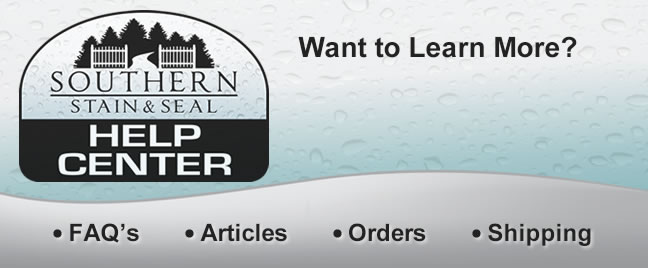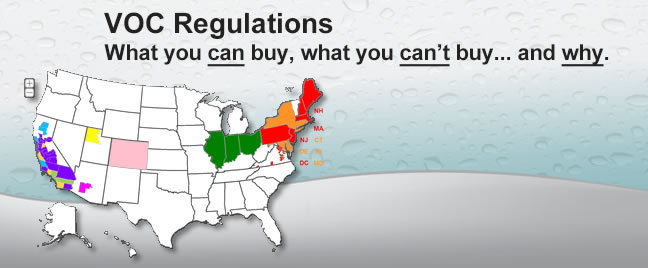Concrete is used in all types of outdoor construction. It is one of the most common materials used to build driveways, pool decks, patios, porches and sidewalks. Outdoors, you will find three basic types of concrete: Stamped Concrete, Broom Swept Concrete and Exposed Aggregate. All types of concrete are extremely hard and durable, but they are also easily damaged by freezing water, oil, salt and erosion. Sealing your concrete will not only preserve its appearance, but also extend its life and protect your investment.
There are many different choices when it comes to deciding which concrete or cement sealer is right for your outdoor sealing project. Durability, cost and appearance will all play a part in the decision you make. If your concrete has ever been sealed in the past, you will also need to consider the new sealer’s compatibility with your existing sealer. We offer a full range of sealer options for all types of driveway, patio, sidewalk and outdoor sealing projects.
Below, we will take a look at the three types of concrete typically found outdoors. For each type of concrete, we will discuss basic cleaning and preparation techniques, along with the different types of sealers available for each type of surface. In addition to the resources here in the “help center”, you can also find detailed information about every product we offer, by visiting that product’s page. We know how confusing all of this can be, but that’s what we’re here for! If you have questions, give us a call or send us an email and we’ll be glad to help you through the process.
Exposed Aggregate Concrete
Exposed aggregate concrete is very popular for the construction of driveways, patios and sidewalks. It is also commonly known as pea gravel concrete, pebble concrete or exposed chip, depending on the type of rock used in the mix. This appearance is achieved by actually removing the top layer of cement after the concrete is poured. Although the surface is extremely resistant to wear, it is also extremely porous and vulnerable to erosion, salt and freeze thaw damage. Over just a short period of time salt or freezing water in the concrete can quickly cause the stones to loosen and break away from the surface causing irreversible damage. It is extremely important to seal and waterproof exposed aggregate to prevent this kind of damage. We have sealers available to also enhance the color and provide a beautiful wet look, as well as penetrating sealers that protect while leaving a completely natural appearance.
Step 1:
Aggregate Concrete Cleaning and Preparation
As with all projects, proper preparation is the MOST important step! Before a protective treatment can be applied, any non-compatible existing sealers MUST be removed and the surface completely cleaned and de-greased to ensure adhesion and penetration. In most cases, a thorough pressure washing is all that is needed for bare, un-sealed aggregate concrete. For the best appearance and protection, all cracks should be filled or repaired to prevent water penetration.
- Recommended Products:
 F9 Double Eagle
F9 Double Eagle
Degreaser Nock-Off
Nock-Off
Coating Stripper Surf-Prep
Surf-Prep
Etching Cleaner
Sealing Option 1:
Wet Look Solvent Based Acrylic Sealers
These are our most popular sealers for exposed aggregate concrete. We offer these in clear, and also tinted brown to match and / or enhance your aggregate concrete. These solvent-based sealers are effective, economical and offer easy maintenance. As you search for the “perfect sealer” you will likely come across hundreds of solvent-based acrylics, all claiming to be the “best sealer ever invented”. Truth is, there are only a few basic differences in solvent-based acrylics that are even noticeable to the average user. Many (if not most) are the EXACT same products private labeled over and over with a new claim to fame. For a detailed discussion on these differences, see the “Detailed Info” for any of the acrylics listed below. For most aggregate sealing applications we recommend using a 30% solids premium acrylic. Most solvent-based acrylics are compatible for use over most other solvent-based acrylics, but CANNOT be applied over ANY previous water-based sealer. To maintain protection and appearance, this sealer should have a maintenance coat every 2-3 years.
- Recommended Products:
 Aggreseal
Aggreseal
30% Acrylic Deco-Guard
Deco-Guard
Siloxane Acrylic
Sealing Option 2:
Wet Look Water Based Urethane Sealers
This is the next generation of wet-look aggregate sealers. Although slightly more expensive than the traditional acrylics described above, this type of concrete sealer is superior in almost every way. Urethanes are two-component products that chemically harden like an "epoxy" after you mix part:A and Part:B together. This makes them much harder, more durable and chemical resistant than simple acrylics. Urethanes are also UV stable and will never turn yellow due to UV exposure. Since these urethanes are also water-based, they offer much easier and safer application, without the need for rollers, pans and flammable solvents. These professional grade sealers come in a concentrate form, apply easily by sprayer, are legal for sale in all 50 states and are compatible for use over many types of existing sealers. To maintain protection and appearance, this sealer should have a maintenance coat every 3-5 years. Water-based urethanes provide a rich "wet look" color enhancement and gloss varies from semi-gloss to high-gloss depending on the number of coats applied and dilution ratio used.
- Recommended Products:
 Trident CAT-5
Trident CAT-5
Sealing Option 3:
Penetrating Aggregate Sealers
This type of sealer penetrates into the surface, sealing out water and contaminates. Penetrating sealants work 100% below the surface to protect your aggregate, pea gravel or pebble concrete from within, while still remaining breathable. These sealers do not form a film or change the sheen of the surface. Some such as WB-75 and SB-100 leave a completely natural appearance, while others like Enhancer Shield provide color enhancement for more of that "wet look" many people desire. These are very popular for sidewalk sealing and concrete waterproofing since they do not become slippery when wet, and can never flake, peel or chip like film-forming sealers. These are very effective, long lasting and offer easy application and maintenance. The life-span and level of protection you get from this type of sealer will depend on the quality of the product you choose. Penetrating sealers should never be applied over an existing sealer, unless the previous sealer was a similar and compatible penetrating sealer.
Stamped Concrete
This is concrete that has been stamped with a pattern to resemble natural stone or brick. Most stamped concrete is also colored or stained during or immediately after the stamping process. Almost all stains and sealers are suitable for new stamped concrete, but for restoration of existing stamped concrete, you should always test for compatibility with your existing sealer before application. As part of the restoration process, you may also need to remove an existing or failed sealer before re-sealing. In most cases this stripping process will also remove most or all of the color applied to the stamped concrete. If you need to restore or re-color your stamped concrete, be sure to see our “Help Center” page specifically for staining and re-coloring stamped concrete.
Step 1:
Stamped Concrete Cleaning and Preparation
As with all projects, proper preparation is the MOST important step! Before a protective treatment can be applied, any non-compatible existing sealers MUST be removed and the surface completely cleaned and de-greased to ensure adhesion and penetration. In most cases, a thorough pressure washing is all that is needed before re-sealing stamped concrete that is still in good condition. If your stamped concrete has an existing sealer that has failed, turned yellow or is incompatible with the new sealer you want to use, you will need to remove the old sealer before re-sealing. In most cases this stripping process will also remove most or all of the color applied to the stamped concrete. If you need to restore or re-color your stamped concrete, be sure to see our “Help Center” page specifically for staining and re-coloring stamped concrete.
- Recommended Products:
 F9 Double Eagle
F9 Double Eagle
Degreaser Nock-Off
Nock-Off
Coating Stripper Surf-Prep
Surf-Prep
Etching Cleaner Malish
Malish
Scrubbing Brushes
Sealing Option 1:
Wet Look Solvent Based Acrylic Sealers
These are our most popular sealers for stamped concrete. We offer these clear sealers in both gloss and matte finishes to fit any style. These solvent-based sealers are effective, economical and offer easy maintenance. As you search for the “perfect sealer” you will likely come across hundreds of solvent-based acrylics, all claiming to be the “best sealer ever invented”. Truth is, there are only a few basic differences in solvent-based acrylics that are even noticeable to the average user. Many (if not most) are the EXACT same products private labeled over and over with a new claim to fame. For a detailed discussion on these differences, see the “Detailed Info” for any of the acrylics listed below. For most stamped concrete sealing applications we recommend using a 25% solids premium pure acrylic. Most solvent-based acrylics are compatible for use over most other solvent-based acrylics, but CANNOT be applied over ANY previous water-based sealer. To maintain protection and appearance, this sealer should have a maintenance coat every 2-3 years.
- Recommended Products:
 Stamp-Seal
Stamp-Seal
25% Pure Acrylic Deco-Guard
Deco-Guard
Siloxane Acrylic
Sealing Option 2:
Wet Look Water Based Urethane Sealers
This is the next generation of wet-look stamped concrete sealers. Although slightly more expensive than the traditional acrylics described above, this type of concrete sealer is superior in almost every way. Urethanes are two-component products that chemically harden like an "epoxy" after you mix part:A and Part:B together. This makes them much harder, more durable and chemical resistant than simple acrylics. Urethanes are also UV stable and will never turn yellow due to UV exposure. Since these urethanes are also water-based, they offer much easier and safer application, without the need for rollers, pans and flammable solvents. These professional grade sealers come in a concentrate form, apply easily by sprayer, are legal for sale in all 50 states and are compatible for use over many types of existing sealers. To maintain protection and appearance, this sealer should have a maintenance coat every 3-5 years. Water-based urethanes provide a rich "wet look" color enhancement and gloss varies from semi-gloss to high-gloss depending on the number of coats applied and dilution ratio used.
- Recommended Products:
 Trident CAT-5
Trident CAT-5
Broom Swept Concrete
This is plain old regular everyday concrete. It is usually gray in color with a rough texture. This is the concrete commonly found on driveways, sidewalks and parking lots. The textured surface is made-up of a thin layer of sand and cement. Unfortunately it doesn’t take long for water, snow, salt and traffic to wear it away. Because of it’s light color and porous surface, stains from oil, grease and dirt will soon form. A seal coat will protect your concrete and make your driveway cleaning much easier. We have sealers available to also enhance the color and provide a beautiful wet look, as well as penetrating sealers that protect while leaving a completely natural appearance. Almost all stains and sealers are suitable for new concrete, but if your concrete has been previously sealed, you should always test for compatibility before application.
Step 1:
Concrete Cleaning and Preparation
As with all projects, proper preparation is the MOST important step! Before a protective treatment can be applied, any non-compatible existing sealers MUST be removed and the surface completely cleaned and de-greased to ensure adhesion and penetration. In most cases, a thorough pressure washing is all that is needed before sealing broom-swept concrete that is still in good condition. If your concrete has an existing sealer that has failed, turned yellow or is incompatible with the new sealer you want to use, you will need to remove the old sealer before re-sealing. In many cases this stripping process will also remove any stains or colors that may have been applied to the concrete. If you need to restore or re-color your concrete, be sure to see our “Help Center” page specifically for staining and re-coloring outdoor concrete.
- Recommended Products:
 F9 Double Eagle
F9 Double Eagle
Degreaser Nock-Off
Nock-Off
Coating Stripper Surf-Prep
Surf-Prep
Etching Cleaner
Sealing Option 1:
Wet Look Solvent Based Acrylic Sealers
These sealers work well on most colored, stained or dyed broom swept concrete. They offer good protection and excellent color enhancement. These usually aren’t recommended on un-colored broom swept concrete as they will darken and discolor this type of concrete. We offer these clear sealers in both gloss and matte finishes to fit any style. These solvent-based sealers are effective, economical and offer easy maintenance. As you search for the “perfect sealer” you will likely come across hundreds of solvent-based acrylics, all claiming to be the “best sealer ever invented”. Truth is, there are only a few basic differences in solvent-based acrylics that are even noticeable to the average user. Many (if not most) are the EXACT same products private labeled over and over with a new claim to fame. For a detailed discussion on these differences, see the “Detailed Info” for any of the acrylics listed below. For most concrete sealing applications we recommend using a 25% solids premium pure acrylic. Most solvent-based acrylics are compatible for use over most other solvent-based acrylics, but CANNOT be applied over ANY previous water-based sealer. To maintain protection and appearance, this sealer should have a maintenance coat every 2-3 years.
- Recommended Products:
 2000 Supreme
2000 Supreme
25% Pure Acrylic Deco-Guard
Deco-Guard
Siloxane Acrylic
Sealing Option 2:
Wet Look Water Based Urethane Sealers
This is the next generation of wet-look concrete sealers. Although slightly more expensive than the traditional acrylics described above, this type of concrete sealer is superior in almost every way. Urethanes are two-component products that chemically harden like an "epoxy" after you mix part:A and Part:B together. This makes them much harder, more durable and chemical resistant than simple acrylics. Urethanes are also UV stable and will never turn yellow due to UV exposure. Since these urethanes are also water-based, they offer much easier and safer application, without the need for rollers, pans and flammable solvents. These professional grade sealers come in a concentrate form, apply easily by sprayer, are legal for sale in all 50 states and are compatible for use over many types of existing sealers. To maintain protection and appearance, this sealer should have a maintenance coat every 3-5 years. Water-based urethanes provide a rich "wet look" color enhancement and gloss varies from semi-gloss to high-gloss depending on the number of coats applied and dilution ratio used.
- Recommended Products:
 Trident CAT-5
Trident CAT-5
Sealing Option 3:
Penetrating Concrete Sealers
This type of sealer penetrates into the surface, sealing out water and contaminates. Penetrating sealants work 100% below the surface to protect your concrete from within, while still remaining breathable. These sealers do not form a film or change the sheen of the surface. Some such as WB-75 and SB-100 leave a completely natural appearance, while others like Enhancer Shield provide color enhancement for more of that "wet look" many people desire. These are very popular for sidewalk sealing and concrete waterproofing since they do not become slippery when wet, and can never flake, peel or chip like film-forming sealers. These are very effective, long lasting and offer easy application and maintenance. The life-span and level of protection you get from this type of sealer will depend on the quality of the product you choose. Penetrating sealers should never be applied over an existing sealer, unless the previous sealer was a similar and compatible penetrating sealer.





















